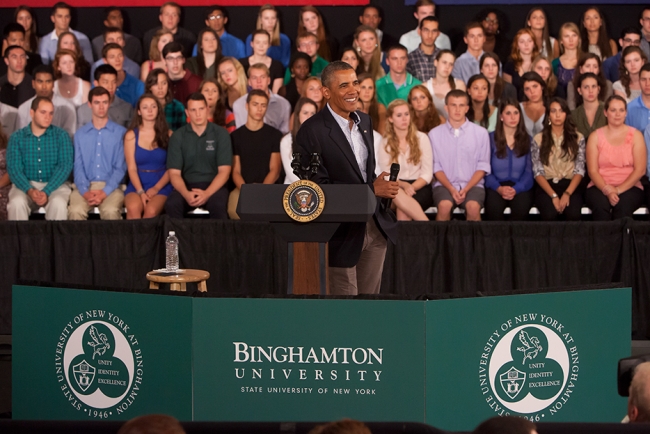You have /5 articles left.
Sign up for a free account or log in.

President Obama at Binghamton meeting with students
Photo by Jonathan Cohen
In unveiling his ambitious second-term higher education agenda last week, President Obama teed up a wide-ranging debate -- and possibly a contentious fight -- over how, or whether, to overhaul the nation’s financial aid system in a way that links federal support to colleges' and universities' performance.
Though it was released with the fanfare of a two-day, three-campus bus tour and a promise to “shake up” the status quo, Obama’s proposal is largely a continuation of a nearly decadelong effort to make institutions of higher education more accountable for student outcomes. That was a major theme of the Spellings Commission, announced in 2005 under the former Bush administration Education Secretary Margaret Spellings. Obama’s administration has echoed, in both policy and rhetoric, that accountability theme, with the president notably warning colleges in his 2012 State of the Union address that they would see a reduction in federal support if they did not keep down rising tuition rates. That rhetoric has translated into some policy proposals, too, such as earlier this year when the administration announced a college "scorecard" that would compare institutions based on a range of metrics.
This growing attention on performance-driven indicators has largely been resisted by traditional institutions of higher education in the past -- sometimes in forceful terms. With the most recent proposal, though, the lobbyists representing many sectors of traditional higher education say they’re not drawing up lobbying strategies just yet.
In part, that’s because Obama’s plan is still largely unformulated, at least publicly. Although last week’s proposals represent administration officials’ most detailed ideas to date on how they want to make good on a promise to hold colleges more accountable for the rising price of higher education, it is still unclear what a revamped federal student aid program would look like.
“We don’t know what, exactly, we’re facing,” said Sarah Flanagan, vice president for government relations and policy at the National Association of Independent Colleges and Universities. “You’re not seeing a lot of firm statements from groups advocating one way or the other, because I don’t think we really know what this is yet.”
Flanagan said that private colleges would be more likely to get behind a policy geared toward providing consumer information to students, but that they wouldn’t embrace a system in which “all schools are going to be labeled ‘good’ or ‘bad.' ”
Aside from the specifics of the proposals, college and university advocates said it’s also difficult to judge the likelihood that the plan will actually be implemented.
“Because these are fairly nebulous proposals at this point and because they’re so sweeping, it is hard to get your arms around them politically,” said David Baime, senior vice president for government relations and research at the American Association of Community Colleges.
The administration’s proposals will attract a lot of attention, Baime said, but it’s difficult to assess just how much traction they would have amid the myriad ideas floating around for renewing the Higher Education Act. The process of rewriting the massive law that governs federal student aid began earlier this year with preliminary hearings that are expected to continue this fall, but if recent history is any guide, it could be years before Congress passes it.
Obama said last week that he wanted to implement a ratings system for colleges by 2015 and have student aid linked to that system by 2018.
Some higher education advocates said that they also viewed the vague nature of the plans as an opportunity to shape the policy when the administration seeks input from higher education (and other constituents) on the plans, a process expected to begin this fall. The Education Department says it’s planning a mix of town hall meetings, listening sessions and meetings with higher education advocates in Washington.
“In the coming months the administration looks forward to continuing the conversation with stakeholders across the country to ensure that everyone -- states, institutions, and students -- does their part to bring down the cost of college,” said Stephen Spector, a spokesman for the Education Department, who declined to offer any further details.
But it’s not clear how -- and how enthusiastically -- traditional higher education institutions would seek to influence the development of metrics for a ratings system they would likely resist when it is used to direct where federal aid dollars go.
“Higher education is very open and eager to explore an array of methodologies, but the evidence so far and the work that has been done by the best scholars and independent analysts suggest that this is a very tough thing to do,” said Molly Corbett Broad, president of the American Council on Education.
The diversity of types of higher education institutions may also mean that trying to create a broad rating system, even if it were to compare institutions among to-be-specified “peer groups” as Obama suggested, would produce division in what different types of institutions would push for.
Broad, whose group serves as an umbrella group for higher education lobbying efforts, says that its approach will be to first achieve consensus among higher education constituencies and then proceed to engage with the administration.
“Our most effective strategy is when we can speak with one voice, notwithstanding the diversity of institutional types,” said Broad. “It’s the most powerful influence we have, so we’re going to try to build a consensus and then try to offer some reasonable recommendations.”
Expanded Federal Involvement
Obama’s proposal, if enacted, has the potential to represent one of the more significant instances of federal involvement in higher education in some time. The relatively restrained responses of many higher education groups -- a notable exception being of the Association of Public and Land-grant Universities, which supported the president’s plan -- stands in contrast to more vigorous reactions to previous efforts by the government to exert oversight of higher education.
Earlier this year, for instance, some higher education groups pushed back against a college “scorecard” aimed at allowing students to more informed financial decisions about picking a college, decrying it as too simple and incomplete. And the for-profit education lobby has vigorously pushed back against attempts by the administration to restrict federal student aid dollars to institutions that don’t meet certain performance standards.
Still, although many associations representing traditional higher education institutions were somewhat muted in their response to Obama’s plan, labor interests have come out forcefully against many parts of the plan.
“Rating systems affect the natural evolution of colleges, which have been striving to implement many types of student success programs on their own,” Sandra Schroeder, chair of the American Federation of Teacher’s higher education program and policy council, said in an e-mail. “Trying to hold colleges and universities accountable for their performance when we have not first ensured that they have the proper resources and that those resources are best focused to help students succeed, will only penalize students in the long run.”
The American Association of University Professors decried Obama’s proposal as “little more than a version of the failed policy of ‘No Child Left Behind’ brought to higher education.”
Rudy Fichtenbaum, the group’s president, said he did not have any specific plans on how the AAUP would advocate against the proposals, but said he thought it would be misguided for institutions of higher education and their advocates to help develop the metrics by which the Obama administration wants to rate them.
“I don’t see any room to try and develop some kind of compromise on testing and ranking. I just think it’s the wrong approach,” said Fichtenbaum, who is also a professor of economics at Wright State University. “The people who run our institutions have a sort of vested interest to maybe see how they can shape the metrics around the edges to preserve what they have. What they will be engaged in doing is rearranging the deck chairs on the Titanic, and what we want to do is to plug the hole and keep the ship from sinking.”
Federal policy makers and higher education should instead focus energy on more pressing issues, Fichtenbaum said, such as the drastic reductions in state appropriations and administrative bloat on college campuses.








